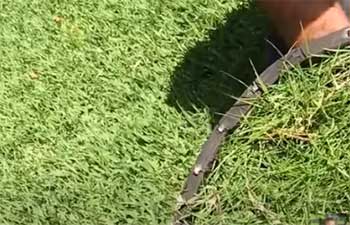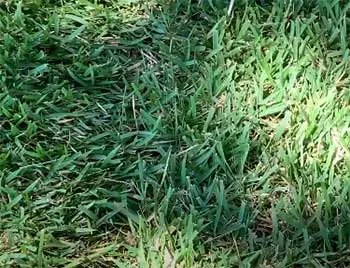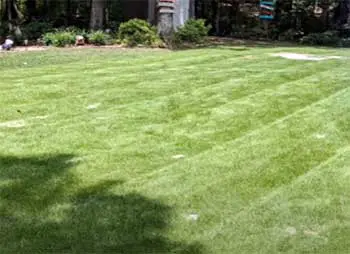Looking forward to giving your lawn a beautiful makeover with Zoysia turf grass?
If so, you must consider Zeon and Palisades grasses as they’re the best. You might think about which one you should choose, right?
Well, this comparison guide will help a lot to find out.
Among many other differences, Zenon Zoysia has a medium green color. But Palisades Zoysia has dark green color. Besides, Zenon’s mowing height can get as low as 3/8 inches, whereas Palisades’ mowing height is 1 to 3 inches.
Choosing the right turfgrass from the two best options requires comprehensive knowledge of both of them. Let’s check out their differences.
A Quick Comparison Table
Here is a quick comparison table between Zeon and Palisades Zoysia grass:
| Aspects | Zeon Zoysia | Palisades Zoysia |
| Grass Type | Extremely Adaptive Zoysia Grass | High Growth Zoysia Grass |
| Special Feature | greens up early in the spring and stays late | highly dense turfgrass |
| Benefits | Offers More Benefits | Offers Fewer Benefits |
| Watering | 1 Inch Per Week | 3-4 Inches Per Week |
| Mowing Size | 1 to 1½ Inches | 1 to 2 Inches |
| Insect & Disease Control | Excellent | Medium |
In-Depth Comparisons Between Zeon And Palisades Zoysia Grass
Now that you have drawn some quick knowledge from the above comparison table, it will be farther easier for you when we get into details. You can quickly relate to them now.
Here are some comprehensive key differences between Zeon and Palisades Zoysia grass:
- Grass Type

Zenon and Palisades are both Zoysia grass, including all the characteristics.
But even so, there are many differences between them. Let’s explore them.
Zenon Zoysia sod is highly adaptive to hot and cold weather. It not only tolerates but also thrives in the heat of the south and the cold of the north.
The most exciting fact about this grass is that it was used on the golf course of the 2016 Brazil Olympics.
So, you can boast of having Olympic grass on your lawn.
On the contrary, people call Palisades Zoysia a friendly grass because of its impressive growth rate in any given weather condition. It is a medium to coarse textured turfgrass known for low water consumption and shade tolerance.
- Grass Features
Being a similar breed, you will find many identical features between these two types of grass. We will see some key features to understand which one is better.
You will get exceptional shade & drought tolerance from Zenon Zoysia grass. With a medium green color, it appeals to extraordinary visuals. It greens up early in the spring and stays late.
Besides, the grass features firm root and rhizome production. You will be amazed by its fine-blade vertical leaf posture.
On the other hand, Palisades Zoysia is a highly dense turfgrass that will make your home lawn look more attractive. It’s a shade-tolerant and low-maintenance grass that has coarse-textured turf.
Besides, this grass can also tolerate salt and drought. Plus, it reproduces quickly, even in harsh weather.
- Benefits

As a next-generation Zoysia grass, Zeno presents itself as a fine-textured turf with a lot of tolerance.
You can plant it in a shady area; it will grow and become thick.
It comes with excellent adaptability and thrives in extreme hot and cold weather.
Besides, you won’t have to invest many human resources and money in maintaining this grass.
Similarly, Palisades Zoysia has excellent cold, heat, drought, shade tolerance, and wear resistance. It overgrows and becomes thick in a short period. Plus, it can tolerate a high volume of foot traffic.
It requires low light and low maintenance but makes your lawn look more attractive.
- Watering
As we already know, both Zoysia types of grass are low maintenance and require less water to grow. However, Zenon only requires 1 inch of water per week.
Conversely, Palisades requires 3 inches of water for the first couple of weeks. Later you can reduce the amount of water. You will need 3 to 4 inches of water for sandy soil.
- Mowing Size
When your Zenon grass sets up on your lawn, you will have to mow it every 7 to 10 days. You should maintain a 1-inch to 1½ inches height for a better looking.
But never trim more than 1/3 inches leaf off at one mowing.
In contrast, Palisades requires mowing every 7 days after being established on the lawn. A mowing height of 1½ inches to 2 inches will look optimum. You can use a rotary mower to cut this grass.
- Disease & Insect Tolerance
Zeon grass is remarkably tolerant to most common lawn insects and pests like Grubs and Billbugs. WThe proper preventive measures can also resist Armyworms in newly set sods.
If you manage water and fertility, the disease won’t be a problem for Zeon grass. You can use organic compost and spring compost topdressing once a year to minimize illness.
Palisades also has a pretty good reputation for disease and insect control. With proper care and maintenance, you won’t have to worry about them at all.
- Growth Habit and Texture

Zeon and Palisades both spread quickly and vigorously to form a dense, soft carpet of lush green blades. But Zeon’s growth habit and leaf texture gives it a slight edge.
Zeon zoysia grows via above-ground stolons at a rapid rate. It forms a very dense mat, choking out weeds and other grasses. Zeon’s fine leaf texture is unrivaled, with narrow blades that measure just 1/16 inches across. This gives Zeon a delicate, almost wispy appearance.
Palisades zoysia also has a fast grow-in rate. And it produces a dense, quality turf. However, its leaf texture is slightly wider than Zeon’s, averaging 1/8 inch across. So Palisades lacks that exceptionally fine, soft leaf texture of Zeon.
Advantage: Zeon for its unparalleled narrow leaf width and soft feel.
- Color
Both Zeon and Palisades zoysia exhibit excellent dark green colors that make for an attractive lawn. However, Palisades exhibits a deeper green hue throughout the growing season.
Zeon zoysia presents a pleasing medium to dark green. During peak growing seasons, Zeon typically registers around 6.0 on the turf color spectrum. This indicates a color between green and dark green.
Palisades zoysia displays a beautiful deep emerald color. It normally ranks around 5.0 on the turf color spectrum, meaning it falls closer to a true dark green versus Zeon. Palisades also holds its rich color later into the fall compared to Zeon.
For homeowners who prioritize a dark green lawn, Palisades zoysia’s rich color gives it the upper hand.
Advantage: Palisades for its darker green color.
- Density
Density is vital for a lush, full lawn free of weeds and bare spots. Both Zeon and Palisades zysia excel in this area, forming a thick carpet of grass. But Zeon’s growth habit gives it the edge.
Zeon zoysia is an extremely vigorous grower that rapidly produces dense mats of stolons and rhizomes. Over time, Zeon outcompetes all other grasses and weeds to form a lawn of unrivaled density and coverage. Zeon forms such a persistent mat of stolons that it can be difficult to find the soil beneath its thick carpet of stems and leaves.
While Palisades zoysia also demonstrates good sod density, it cannot quite match Zeon’s prolific growth. Palisades results in a quality turf, but is slightly more prone to invasion by weeds and unsightly bare areas in high traffic zones.
For a completely carpeted lawn, Zeon is the superior choice.
Advantage: Zeon for its unbeatable mat-forming density.
- Cold Tolerance
Good cold tolerance allows zoysia grass to thrive as far north as the transition zone, unlike other warm season grasses. Zeon and Palisades are both sufficiently cold hardy, but Palisades is better equipped to handle cooler zones.
Zeon zoysia tolerates cold temperatures down to 0 degrees Fahrenheit. It can survive as far north as USDA hardiness zone 6. However, it may experience winterkill and be slow to green up in spring in the cooler end of its range.
Palisades tolerates cold better than Zeon, withstanding temperatures as low as -10 degrees Fahrenheit. It readily grows as far north as USDA zone 7, and may persist even into zone 6 with proper care. Palisades greens up earlier in spring than Zeon following winter dormancy.
For northern lawns, Palisades is the best bet to maximize cold hardiness.
Advantage: Palisades for improved cold tolerance.
- Shade Tolerance
The ability to grow in partial shade is a major plus, allowing zoysia to thrive under trees and other shaded areas of the landscape. Both grasses tolerate moderate shade, but Palisades excels in lower light conditions.

Zeon zoysia demonstrates good overall shade tolerance for a warm season grass.
It can handle up to 4 hours of light daily shade, and retains acceptable quality even in moderate shade.
However, it may become thinner and weaker over time if planted primarily in shady spots.
Palisades zoysia exhibits excellent shade tolerance, retaining its lush growth even with only 2-4 hours of direct sun per day. Palisades tolerates deeper shade better than most zoysia cultivars, and will thrive under light to moderate shade.
For persistently shady lawns, Palisades is the top choice.
Advantage: Palisades thanks to its exceptional shade tolerance.
- Drought Tolerance
The outstanding drought resistance of zoysia grass makes it a great choice for low water use landscapes. Both Zeon and Palisades demonstrate excellent drought tolerance, but Zeon has a slight edge.
Zeon zoysia possesses a robust root system coupled withnarrow blades and waxy leaves. This allows Zeon to withstand very dry conditions and recover quickly after watering restrictions. Zeon can go without irrigation for 4-6 weeks in summer while maintaining acceptable quality.
Palisades zoysia also exhibits impressive drought resistance due to its deep root system and water-conserving leaf characteristics. However, it cannot quite match Zeon’s capacity to thrive under prolonged drought. Palisades may require slightly more frequent watering to look its best.
For maximum irrigation efficiency, Zeon is the best selection.
Advantage: Zeon for its exceptional drought endurance.
- Salt Tolerance
Good salt tolerance enhances zoysia’s durability in coastal regions and areas with salty irrigation water. Zeon demonstrates better overall salt tolerance compared to Palisades.
Zeon zoysia has relatively good tolerance to salt accumulation in soil. It can handle occasional salt exposure without much decline in appearance or die out. This makes Zeon a decent selection for oceanfront landscapes.
Palisades zoysia has only moderate salt tolerance. It does not perform well in chronically salty soils, and may sustain damage from exposure to ocean spray or salty water. Palisades is not recommended for use in beach areas.
Zeon is clearly the better pick for salt-laden environments.
Advantage: Zeon thanks to good salt tolerance.
- Thatch Buildup
Thatch is a tightly intermingled layer of stems and roots that accumulates above the soil surface. Excessive thatch restricts water, air, and nutrient penetration into the soil. It can lead to issues like drought stress, disease, and weakened turfgrass. Both Zeon and Palisades exhibit minimal thatch buildup over time.

Zeon zoysia is praised for producing very little thatch due to its slower vertical growth habit.
Most thatch that does accumulate is near the surface and easy to remove with proper practices like aeration.
Zeon requires less aggressive dethatching compared to some zoysia varieties.
Palisades zoysia also demonstrates slow thatch accumulation.
While it may build up marginally more thatch than Zeon, it still requires far less dethatching than other grasses. Thatch control is easy with proper yearly maintenance.
Overall, thatch accumulation is not a major concern with either cultivar. Both Zeon and Palisades rate well in this category.
Advantage: Neutral. Both grasses minimize thatch buildup.
- Mowing and Care
In terms of regular mowing and care, Zeon and Palisades are again quite comparable. As zoysia grasses, they both require less intensive upkeep once established.
Zeon zoysia should be mowed at a height of 0.5-2 inches. It can be maintained as low as 0.5 inches if sufficient irrigation is provided. Zeon requires less frequent mowing than other lawn grasses, about 1-2 times per week at peak growth. Annual fertilization and aeration helps keep Zeon looking its best.
Palisades zoysia shares a similar optimal mowing height of 0.5-2 inches. It also excels when mowed around 1-2 times weekly during active growth. Annual fertilizer and aeration is beneficial for Palisades as well.
For routine upkeep, Zeon and Palisades are very similar. Both offer the low maintenance advantage of zoysia.
Advantage: Neutral. Zeon and Palisades have comparable care needs.
Pest and Disease Resistance
Good disease and insect resistance is important for any lawn grass. Zeon and Palisades both demonstrate excellent pest and disease resistance with proper growing conditions.
Zeon zoysia possesses good resistance to most common zoysia diseases, including rust, dollar spot, and leaf spot. Proper cultural practices prevent most disease issues. Zeon is rarely troubled by insect pests, though chinch bugs may sometimes be a concern.
Palisades zoysia shares Zeon’s robust defense against diseases, showing resistance to fungal problems under suitable conditions. Insect pests are not usually an issue. Like Zeon, Palisades may be damaged by chinch bugs in hot and humid climates.
With preventative care, serious pest and disease issues are unlikely in either cultivar.
Advantage: Neutral. Zeon and Palisades offer comparable pest/disease resistance.
- Price
Roughly, a 450 square feet of Zeon Zoysia pallet will cost $315. On the other hand, the same size pallet of Palisades Zoysia will cost $295. So, Zeon is an expensive grass than Palisades.
To learn more about their differences, watch this video!
Which Grass Is Best For You?
I have presented all the necessary aspects of these grasses. Now it shouldn’t be challenging anymore to choose the right one.
Which grass you should select is your discretion, but I would tell you to go for Zeon Zoysia if you ask me.
It has a medium green color, so your lawn won’t look dark. Besides, it has an excellent tolerant level and adaptability in many ways.
You will require very low maintenance as this grass can protect itself excellently from insects and diseases with minimum care.
Frequently Asked Questions (FAQ)
There are many Zoysia types of grass available for residential and commercial use. But Geo Zoysia, Zeon Zoysia, etc., are some of the best grass with superior tolerance and adaptability.
Zeon Zoysia is an Olympic quality grass because it had been used in the Olympics golf course. Among many Zoysia grass, it has the highest insect and disease tolerance and doesn’t need a lot of maintenance.
Zeon Zoysia has better temperature tolerance than Zenith Zoysia. It can tolerate heat and cold very well.
But most importantly, it becomes green very fast in the spring and slowly turns brown in the winter.
Among many Zoysia grass, Zeon Zoysia is the most shade tolerant. It can withstand full sun and shade.
This excellent grass can survive with 4 hours of direct sunlight. Besides, you have to provide 1-inch of water per week.
Final Thoughts
Grass can make your lawn look more attractive. It can also turn your property into a professional-looking golf course.
So, choosing the right grass sod is more than essential; it’s necessary.
I’m happy that you could find the best Zoysia grass from my Zeon vs. Palisades Zoysia article. All you have to do is, purchase the grass and put it on your lawn.
